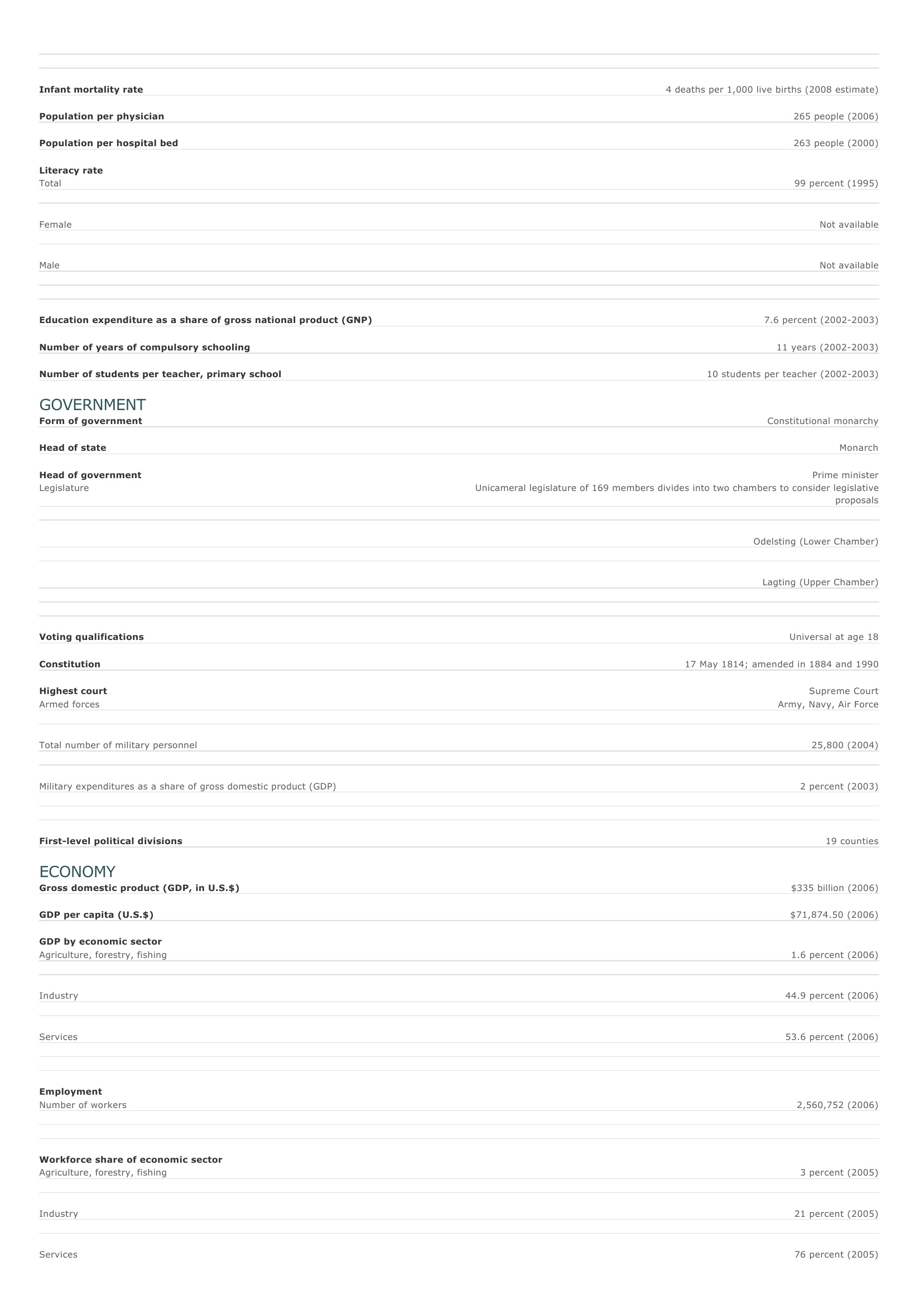Norway Facts and Figures. BASIC FACTS Official name Capital Area Kingdom of Norway Oslo 385,639 sq km 148,896 sq mi PEOPLE Population 4,644,457 (2008 estimate) Population growth Population growth rate 0.35 percent (2008 estimate) Projected population in 2025 4,916,787 (2025 estimate) Projected population in 2050 4,966,385 (2050 estimate) Population density 15 persons per sq km (2008 estimate) 39 persons per sq mi (2008 estimate) Urban/rural distribution Share urban 80 percent (2005 estimate) Share rural 20 percent (2005 estimate) Largest cities, with population Oslo 536,209 (2005 estimate) B ergen 241,440 (2005 estimate) Trondheim 157,813 (2005 estimate) S tavanger 114,936 (2005 estimate) Kristiansand 76,749 (2005 estimate) Ethnic groups Germanic (Nordic, Alpine, Baltic); some 20,000 Saami Languages Norwegian (official), English, small Saami- and Finnish-speaking minorities Religious affiliations Evangelical Lutheran (official) 94 percent Roman Catholic 1 percent Nonreligious 2 percent O ther 3 percent HEALTH AND EDUCATION Life expectancy Total 79.8 years (2008 estimate) Female 82.6 years (2008 estimate) Male 77.2 years (2008 estimate) Infant mortality rate 4 deaths per 1,000 live births (2008 estimate) Population per physician 265 people (2006) Population per hospital bed 263 people (2000) Literacy rate Total 99 percent (1995) Female Not available Male Not available Education expenditure as a share of gross national product (GNP) Number of years of compulsory schooling Number of students per teacher, primary school 7.6 percent (2002-2003) 11 years (2002-2003) 10 students per teacher (2002-2003) GOVERNMENT Form of government Head of state Head of government Legislature Constitutional monarchy Monarch Prime minister Unicameral legislature of 169 members divides into two chambers to consider legislative proposals Odelsting (Lower Chamber) Lagting (Upper Chamber) Voting qualifications Constitution Highest court Armed forces Total number of military personnel Military expenditures as a share of gross domestic product (GDP) First-level political divisions Universal at age 18 17 May 1814; amended in 1884 and 1990 Supreme Court Army, Navy, Air Force 25,800 (2004) 2 percent (2003) 19 counties ECONOMY Gross domestic product (GDP, in U.S.$) $335 billion (2006) GDP per capita (U.S.$) $71,874.50 (2006) GDP by economic sector Agriculture, forestry, fishing 1.6 percent (2006) I ndustry 44.9 percent (2006) Services 53.6 percent (2006) Employment Number of workers Workforce share of economic sector Agriculture, forestry, fishing 2,560,752 (2006) 3 percent (2005) I ndustry 21 percent (2005) Services 76 percent (2005) Unemployment rate 4.4 percent (2004) National budget (U.S.$) Total revenue $168,850 million (2006) Total expenditure $107,523 million (2006) Monetary unit 1 Norwegian krone (NKr), consisting of 100 öre Agriculture Livestock, potatoes, barley, oats, wheat, dairy products Mining Petroleum, natural gas, iron ore, lead, titanium, iron pyrites, coal, zinc, copper Manufacturing Food products, chemicals, paper, nonferrous metals, machinery and transportation equipment Major exports Petroleum and natural gas, nonferrous metals, food products, chemicals, paper, iron and steel Major imports Machinery, transportation equipment, chemical products, clothing and accessories, iron and steel, metal ores Major trade partners for exports United Kingdom, France, Germany, Netherlands, and United States Major trade partners for imports Sweden, Germany, United Kingdom, Denmark, and United States ENERGY, COMMUNICATIONS, AND TRANSPORTATION Electricity production Electricity from thermal sources Electricity from hydroelectric sources Electricity from nuclear sources Electricity from geothermal, solar, and wind sources 0.48 percent (2003 estimate) 98.95 percent (2003 estimate) 0 percent (2003 estimate) 0.57 percent (2003 estimate) Number of radios per 1,000 people 917 (1997) Number of telephones per 1,000 people 461 (2005) Number of televisions per 1,000 people 673 (2000 estimate) Number of Internet hosts per 10,000 people 1,246 (2003) Daily newspaper circulation per 1,000 people 569 (2000) Number of motor vehicles per 1,000 people 527 (2003) Paved road as a share of total roads 78 percent (2002) SOURCES Basic Facts and People sections Area data are from the statistical bureaus of individual countries. Population, population growth rate, and population projections are from the United States Census Bureau, International Programs Center, International Data Base (IDB) (www.census.gov). Urban and rural population data are from the Food and Agriculture Organization (FAO) of the United Nations (UN), FAOSTAT database (www.fao.org). Largest cities population data and political divisions data are from the statistical bureaus of individual countries. Ethnic divisions and religion data are largely from the latest Central Intelligence Agency (CIA) World Factbook and from various country censuses and reports. Language data are largely from the Ethnologue, Languages of the World, Summer Institute of Linguistics International (www.sil.org). Health and Education section Life expectancy and infant mortality data are from the United States Census Bureau, International Programs Center, International database (IDB) (www.census.gov). Population per physician and population per hospital bed data are from the World Health Organization (WHO) (www.who.int). Education data are from the United Nations Educational, Scientific and Cultural Organization (UNESCO) database (www.unesco.org). Government section Government, independence, legislature, constitution, highest court, and voting qualifications data are largely from various government Web sites, the latest Europa World Yearbook, and the latest Central Intelligence Agency (CIA) World Factbook. The armed forces data is from Military Balance. Economy section Gross domestic product (GDP), GDP per capita, GDP by economic sectors, employment, and national budget data are from the World Bank database (www.worldbank.org). Monetary unit, agriculture, mining, manufacturing, exports, imports, and major trade partner information is from the statistical bureaus of individual countries, latest Europa World Yearbook, and various United Nations and International Monetary Fund (IMF) publications. Energy, Communication, and Transportation section Electricity information is from the Energy Information Administration (EIA) database (www.eia.doe.gov). Radio, telephone, television, and newspaper information is from the United Nations Educational, Scientific and Cultural Organization (UNESCO) database (www.unesco.org). Internet hosts, motor vehicles, and road data are from the World Bank database (www.worldbank.org). Note Figures may not total 100 percent due to rounding. Microsoft ® Encarta ® 2009. © 1993-2008 Microsoft Corporation. All rights reserved.

































